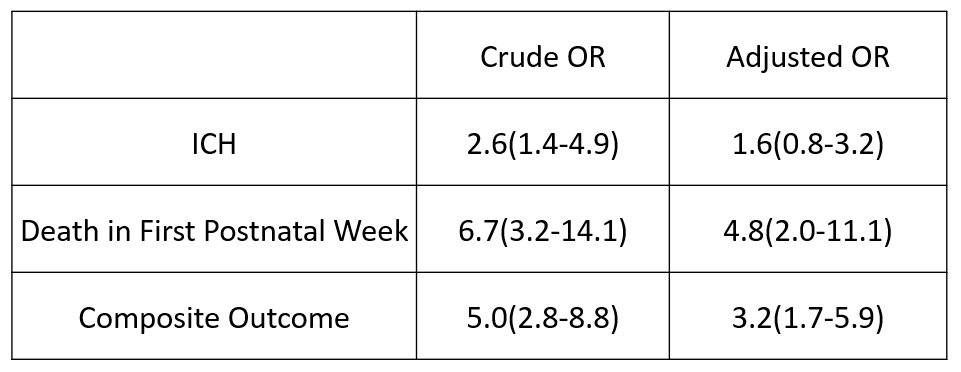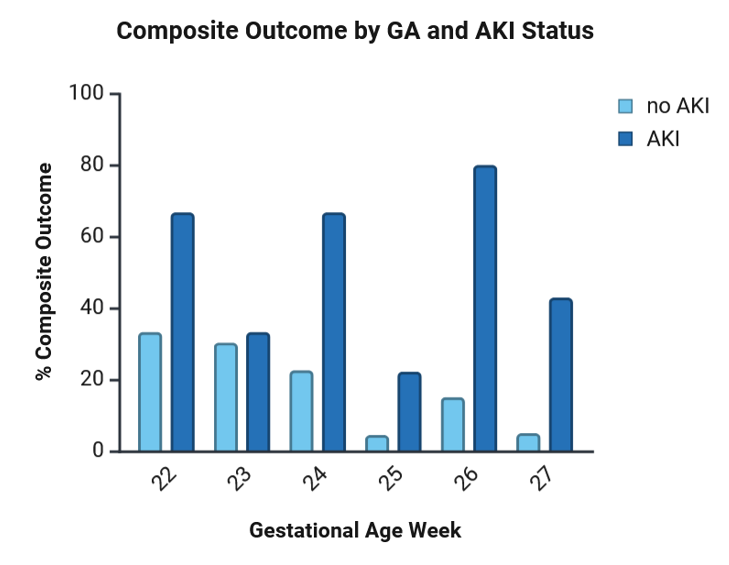Neonatal Nephrology/AKI 1
Session: Neonatal Nephrology/AKI 1
002 - Acute Kidney Injury in the First Postnatal Week Among Extremely Low Gestational Age Neonates is Independently Associated with Severe Intracranial Hemorrhage, Death or Both
Saturday, April 26, 2025
2:30pm - 4:45pm HST
Publication Number: 2.3721
Elad H. Resnick, University of Alabama School of Medicine, Homewood, AL, United States; Russell Griffin, University of Alabama at Birmingham, Birmingham, AL, United States; Namasivayam Ambalavanan, University of Alabama School of Medicine, Birmingham, AL, United States; Colm P. Travers, UAB, Birmingham, AL, United States; David Askenazi, University of alabama at birmingham, Birmingham, AL, United States

Elad H. Resnick, MD (he/him/his)
Fellow
University of Alabama School of Medicine
Homewood, Alabama, United States
Presenting Author(s)
Background: Intracranial hemorrhage (ICH) is a significant cause of mortality and long-term morbidity in extremely low gestational age neonates (ELGANS). While AKI is a known risk factor for mortality and is associated with ICH in preterm infants, its impact on ELGANs who are especially vulnerable to early AKI (within the first postnatal week) remains unclear. Specifically, little is known about early AKI and its association with ICH, death, or both in ELGANs, especially in the 22-24 weeks (w) GA group.
Objective: We had two objectives. The first was to determine the incidence of AKI within the first postnatal week by gestational age among ELGANs. The second was to investigate the association between early AKI and severe ICH, death, or both (herein, the composite).
Design/Methods: We conducted a retrospective cohort study of actively treated ELGANs without congenital anomalies with a GA from ≥22 to < 28 w and a birth weight ≥400 grams inborn 2015-2021 at the University of Alabama at Birmingham regional neonatal intensive care unit. Subjects with less than 2 serum creatinine measurements were excluded. Thus, from 815, we were left with 466 subjects (22w (n=27), 23w (n=87), 24w (n=71), 25w (n=76), 26w (n=98), 27w (n=107)).
AKI was defined using the neonatal KDIGO AKI definition. We defined severe ICH as grade 3-4 and death as mortality within the first postnatal week. In a logistic regression analysis to explore the association between early AKI and composite, we controlled for gestational age, birth weight, Apgar score, sex, race, multiparity, antenatal steroids, and mode of delivery.
Results: The incidence of early AKI was inversely correlated with GA. The incidence of AKI was 6 times higher in 22 w vs. 27 w GA (44% vs. 7% ; p< 0.0001). The composite rate was 3 times higher in patients with AKI compared to those without (48% vs. 15%; p< 0.0001). The composite adjusted odds ratio (aOR) for ELGANs with AKI was 3.2 (95% confidence intervals (CI), 1.7-5.9). The aOR of death was 4.8 (95% CI, 2.0-11.1), and the aOR of severe ICH was 1.6 (95% CI, 0.8-3.2).
Conclusion(s): The incidence of AKI in the first postnatal week among ELGANs is high, inversely correlated with GA, and independently associated with composite. These data suggest that avoiding or treating early postnatal AKI may be an important strategy to improve outcomes in ELGANs.
Future directions include understanding how different etiologies of AKI impact outcomes, controlling for volume status, urine biomarkers of injury, and animal models. Interventional studies directed at treatment and prevention are needed.
Acute Kidney Injury in the First Postnatal Week Among Extremely Low Gestational Age Neonates is Independently Associated with Severe Intracranial Hemorrhage, Death or Both
Confirmation of Program Enrollment - Resnick.pdf
Odds ratios for ICH, Death or the Composite Outcome
 Odds ratios of ICH, death in the first postnatal week, and the composite outcome if a subject had an AKI
Odds ratios of ICH, death in the first postnatal week, and the composite outcome if a subject had an AKIComposite Outcome by Gestational Age and AKI Status
 Incidence of the composite outcome by the gestational age week and AKI status
Incidence of the composite outcome by the gestational age week and AKI status
